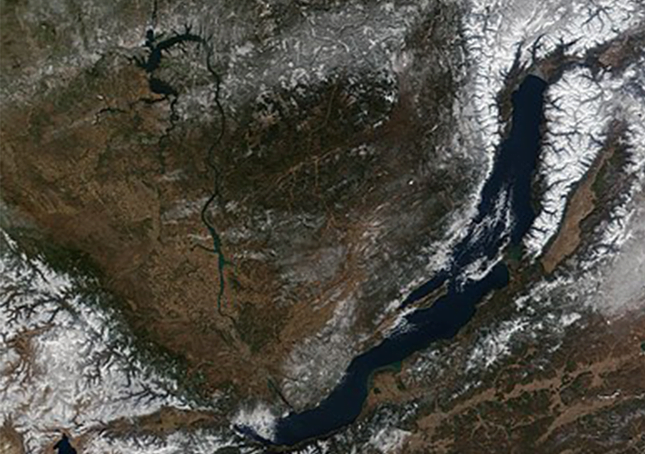Lake Baikal

Lake Baikal (/baɪˈkɑːl, -ˈkæl/;[3] Russian: озеро Байкал, tr. Ozero Baykal, IPA: [ˈozʲɪrə bɐjˈkaɫ]; Buryat: Байгал нуур, Baigal nuur)[4] is a rift lake located in southern Siberia, Russia, between Irkutsk Oblast to the northwest and the Buryat Republic to the southeast.
Lake Baikal is the largest freshwater lake by volume in the world, containing 22 to 23% of the world’s fresh surface water.[5][6] With 23,615.39 km3 (5,670 cu mi) of fresh water,[1] it contains more water than all of the North American Great Lakes combined.[7] With a maximum depth of 1,642 m (5,387 ft),[1] Baikal is the world’s deepest lake.[8] It is among the world’s clearest[9] lakes and is the world’s oldest lake,[10] at 25–30 million years. It is the seventh-largest lake in the world by surface area.
Lake Baikal formed as an ancient rift valley and has a long, crescent shape, with a surface area of 31,722 km2 (12,248 sq mi), slightly larger than Belgium. Baikal is home to thousands of species of plants and animals, many of them endemic to the region. It is also home to Buryat tribes, who raise goats, camels, cattle, sheep, and horses[13] on the eastern side of the lake,[14] where the mean temperature varies from a winter minimum of −19 °C (−2 °F) to a summer maximum of 14 °C (57 °F).
The region to the east of Lake Baikal is referred to as Transbaikalia or as the Transbaikal,[16] and the loosely defined region around the lake itself is sometimes known as Baikalia. UNESCO declared Lake Baikal a World Heritage Site in 1996.
Lake Baikal is in a rift valley, created by the Baikal Rift Zone, where the Earth’s crust is slowly pulling apart.[18] At 636 km (395 mi) long and 79 km (49 mi) wide, Lake Baikal has the largest surface area of any freshwater lake in Asia, at 31,722 km2 (12,248 sq mi), and is the deepest lake in the world at 1,642 m (5,387 ft). The bottom of the lake is 1,186.5 m (3,893 ft) below sea level, but below this lies some 7 km (4.3 mi) of sediment, placing the rift floor some 8–11 km (5.0–6.8 mi) below the surface, the deepest continental rift on Earth.
In geological terms, the rift is young and active – it widens about 2 cm (0.8 in) per year. The fault zone is also seismically active; hot springs occur in the area and notable earthquakes happen every few years.
The lake is divided into three basins: North, Central, and South, with depths about 900 m (3,000 ft), 1,600 m (5,200 ft), and 1,400 m (4,600 ft), respectively. Fault-controlled accommodation zones rising to depths about 300 m (980 ft) separate the basins. The North and Central basins are separated by Academician Ridge, while the area around the Selenga Delta and the Buguldeika Saddle separates the Central and South basins. The lake drains into the Angara, a tributary of the Yenisey. Notable landforms include Cape Ryty on Baikal’s northwest coast.
